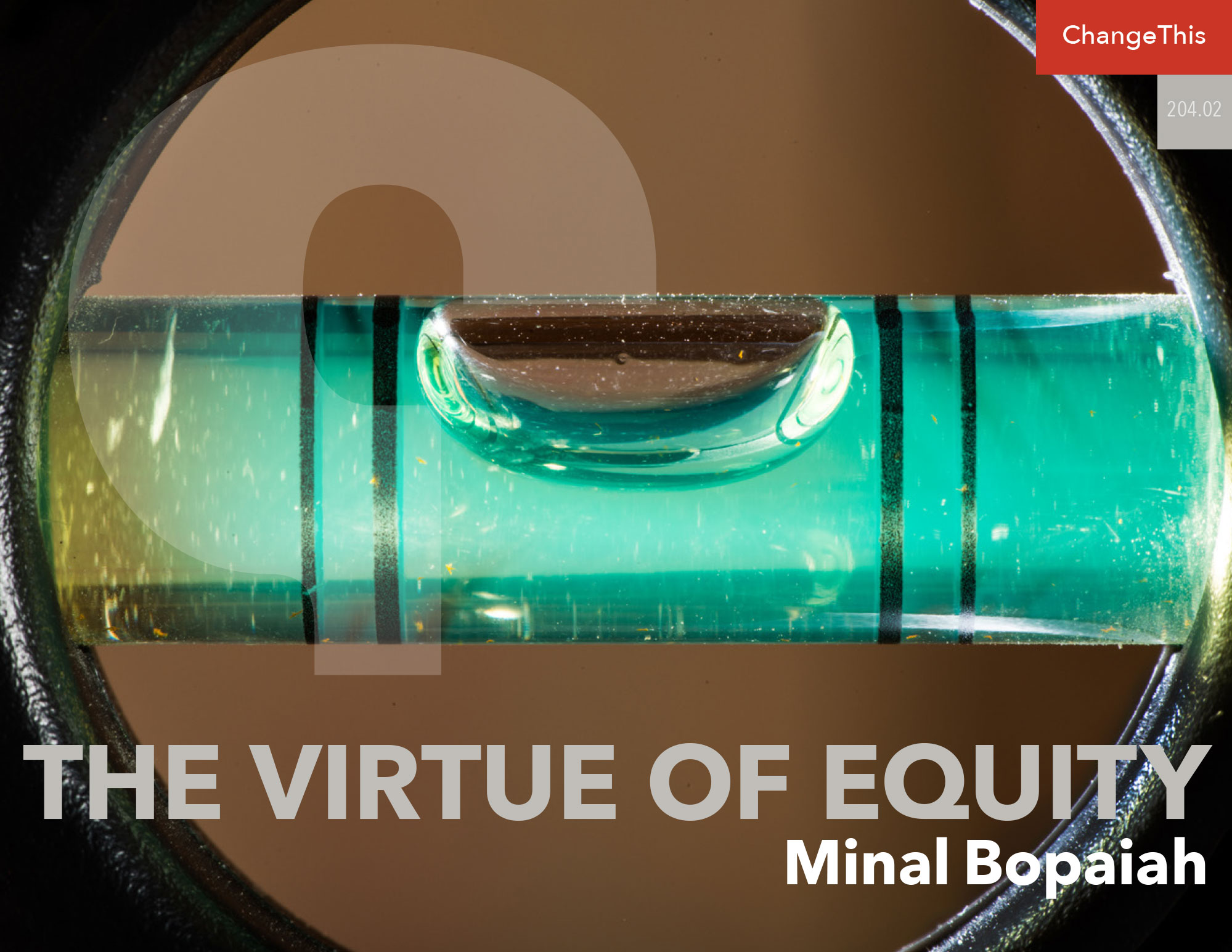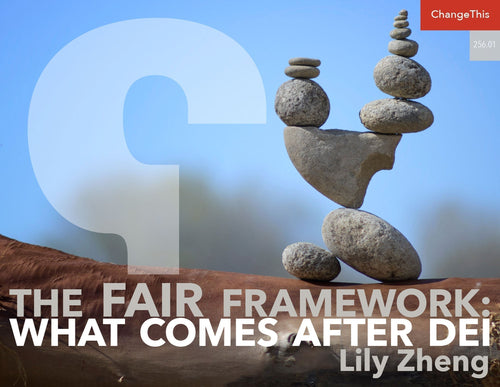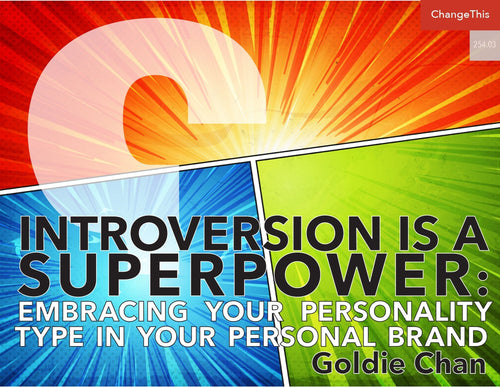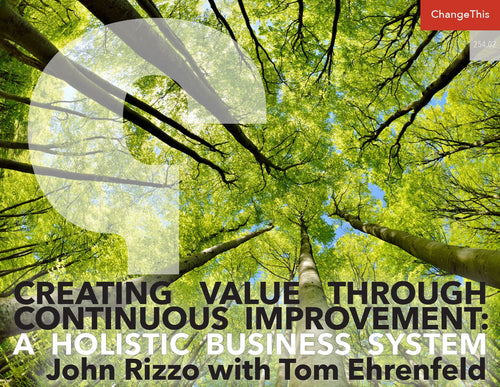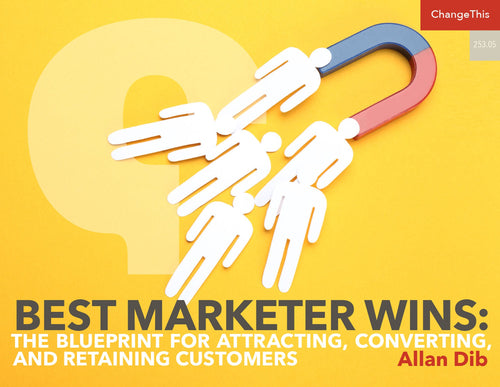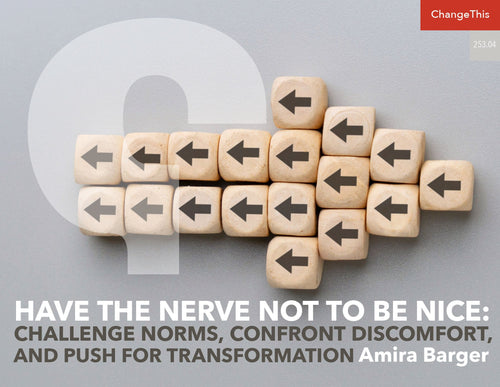The Virtue of Equity
On a bright August day in 1976, my Indian parents arrived in New York City with one suitcase, twenty dollars, and my mother pregnant with me.
They found their way out of the airport (without Google) and headed to Greenpoint, a neighborhood in Brooklyn where they had secured medical residency positions. They began working at a time when New York City’s financial mismanagement, high drug use, and racist “War on Crime” had created an atmosphere of civil war. My father saw more gunshot wounds in one night in the emergency room than in four years of surgical residency in England. For months, my very pregnant mother slept in a sleeping bag on the floor of their apartment. During the New York City blackout of 1977, my father and his colleagues triaged patients in a hospital parking lot illuminated only by the headlights of local fire engines. On an average day, security guards escorted them to and from the hospital buildings because so many medical residents had been mugged by people living with addiction who had been pushed to the fringes of society instead of invited into the hospital for treatment.
Eventually, my parents made it out of Brooklyn, moving to the greener suburbs of Staten Island, and started their own private practice—my mother in pediatrics and my father in colon and rectal surgery. (Their waiting room was always a prickly and entertaining cocktail of people young and old, most of whom didn’t want to be there.) They bought a home and an office building, sent two kids to private school and college debt-free, provided for multiple family members, and contributed to their communities. New York magazine included my father in its annual “Best Doctors” issue eight times. In essence, they lived the proverbial American Dream, working their way up through hard work, determination, and honesty.
That, at least, is one version of their story. A fuller account of their immigration story starts much earlier, in 1965, when the civil rights movement successfully advocated for the Immigration and Naturalization Act, which grants US visas based on labor needs and family ties rather than country of origin. Before that, the US government had an immigration system that explicitly sought to “preserve the ideal of US homogeneity,” meaning a White majority.[1] In other words, no amount of hard work, determination, or honesty would have been enough for my parents to thrive in this country if they had tried to enter before the 1965 act took effect. But even that legislative act of inclusion had its own inequities.
Starting in 1965, the US government began using its immigration system to take advantage of socialized education in other countries to fill its labor needs. My parents, both of whom came from rather humble backgrounds, earned medical degrees in India for a marginal cost (about fifty dollars per semester, according to family lore). That made them prime recruits for a country concerned with a shortage of physicians in the 1960s and ‘70s but wanting to avoid the expense of training doctors.
While my parents came to this country with little monetary wealth, the debt-free medical education they gained in India was a distinct advantage. One might call it a privilege,[2] because this opportunity was certainly not available to the majority of Americans then— or now.
SEEING THE SYSTEM
When my parents and other Indian Americans are held up as members of a so-called model minority—characters in some sort of Horatio Alger tale in which the world is fair and everyone can succeed if they work hard enough—it reinforces a false narrative at best and is vicious gaslighting at worst. This is not to say my parents didn’t work exceptionally hard; I witnessed many of the sacrifices they made to raise my brother and me, achieve their professional goals, and support their family and community. But if the US government offered socialized education as India and other countries do, I believe the percentage of American-born doctors with dark skin and poor parents would rival those in the Indian Diaspora.
Instead, the United States has an education system tied to local property taxes. Most people don’t question this approach to school funding; instead, they look to address disparities in educational opportunity and outcomes through redistricting and busing. But this is just rearranging the proverbial deck chairs on the Titanic. Outside of the United States, this funding design is rare. Most nations use general tax revenue to fund all schools equally and per capita, not by location.[3] As a German friend said of the US school system, “It just means the rich get richer and the poor get poorer.” If we want to address the root cause of educational inequities, we need to have the courage to examine and reimagine how we fund our schools.
But with inequity built into our education system, we continue not only to produce inequitable outcomes but also to extract talent from other countries to fill gaps in our labor needs. Think about this: we are perfectly capable of meeting many of our labor needs if we simply invest in equitable education for all US residents, the way India and many other countries, including our European allies, do. But we choose not to.
This is not an anti-immigrant argument. Our culture benefits from immigration in many ways, and immigrants want to bring their talents to the United States for a host of reasons. (My parents, who eloped in England, have loved the idea of America since they were teenagers, not least of all because it offered them the freedom to be together. They were from different religions and different communities in India, and few people approved of them as a couple.) But it is a grave injustice—and a legacy of the “divide and conquer” mentality of colonialism—that the US educational system does not provide US residents with the quality of education to which immigrants have access in their countries of origin. Each group then blames the other for the country’s problems (echoed in social media outrage like “Immigrants are stealing our jobs!” or “Americans are lazy and don’t want to study or work hard!”). The US education system extracts human resources from other countries rather than investing in the talent and resources of its own residents to give them a fair shot at success.
This is systemic inequality, and the system was designed this way.
The first designer I heard talk about the intersection of systems and design was Antionette Carroll, founder and president of the Creative Reaction Lab, a nonprofit organization that helps design healthy and equitable communities. In an illuminating TED Talk, she says, “When I shifted my understanding of design from object-making to systems-building, I began to realize that systems such as discrimination, racism, sexism, and even poverty were designed by people that made intentional choices around exclusion.”[4] Carroll’s work—an inspiration for many designers, including yours truly—is centered around the fundamental truth that “systems of oppression, inequalities, and inequities are by design. Therefore, only intentional design can dismantle them.”[5]
When we confront the fact that the Founding Fathers designed a system that benefited White men who owned property above all others, we begin to see the legacy of that design in our institutions, governance systems, and organizations. To be fair, designing for inequity isn’t an American invention (although the United States did take it to another level, inspiring the Nazis to study US society so they could figure out how to codify violence and oppression for monetary gain and genocidal outcomes).6 From European colonialism to India’s Vedic caste system, designing for inequity appeals universally to those who are threatened—whether consciously or unconsciously—by the idea of sharing power with others.
Our country’s saving grace—and the saving grace of many nations—is the values enshrined in the living documents governing our society. Values like equality, justice, life, liberty, the pursuit of happiness, freedom, and democracy have allowed generations upon generations of Americans—as well as people of other nations guided by their own intrinsic values of fairness—to iterate the design of their societies. When we dig into these values, we can redesign our educational and immigration systems—two systems that are interdependent— so that they produce equitable outcomes. That would mean that residents in the United States would have access to quality education regardless of their zip code and that immigrants would no longer be used as straw men in anti-Black rhetoric to justify oppression and disenfranchisement. We would begin to understand how systems, not just individual effort, lead to certain outcomes for individuals and groups.
With that understanding, just as we have designed for inequity, we can begin to design for equity.
WHY EQUITY, NOT EQUALITY?
America’s founding documents enshrine equality, so why I am focusing on equity?
First, let’s unpack the difference between these terms. As a writer, I love words, but as the leader of a design firm, I admit that images sometimes convey complex concepts more powerfully. Figure 1, created by the Robert Wood Johnson Foundation, beautifully illustrates the difference between equality and equity. Equality is when everyone has the same thing. Equity is when everyone has what they need to thrive and participate fully.
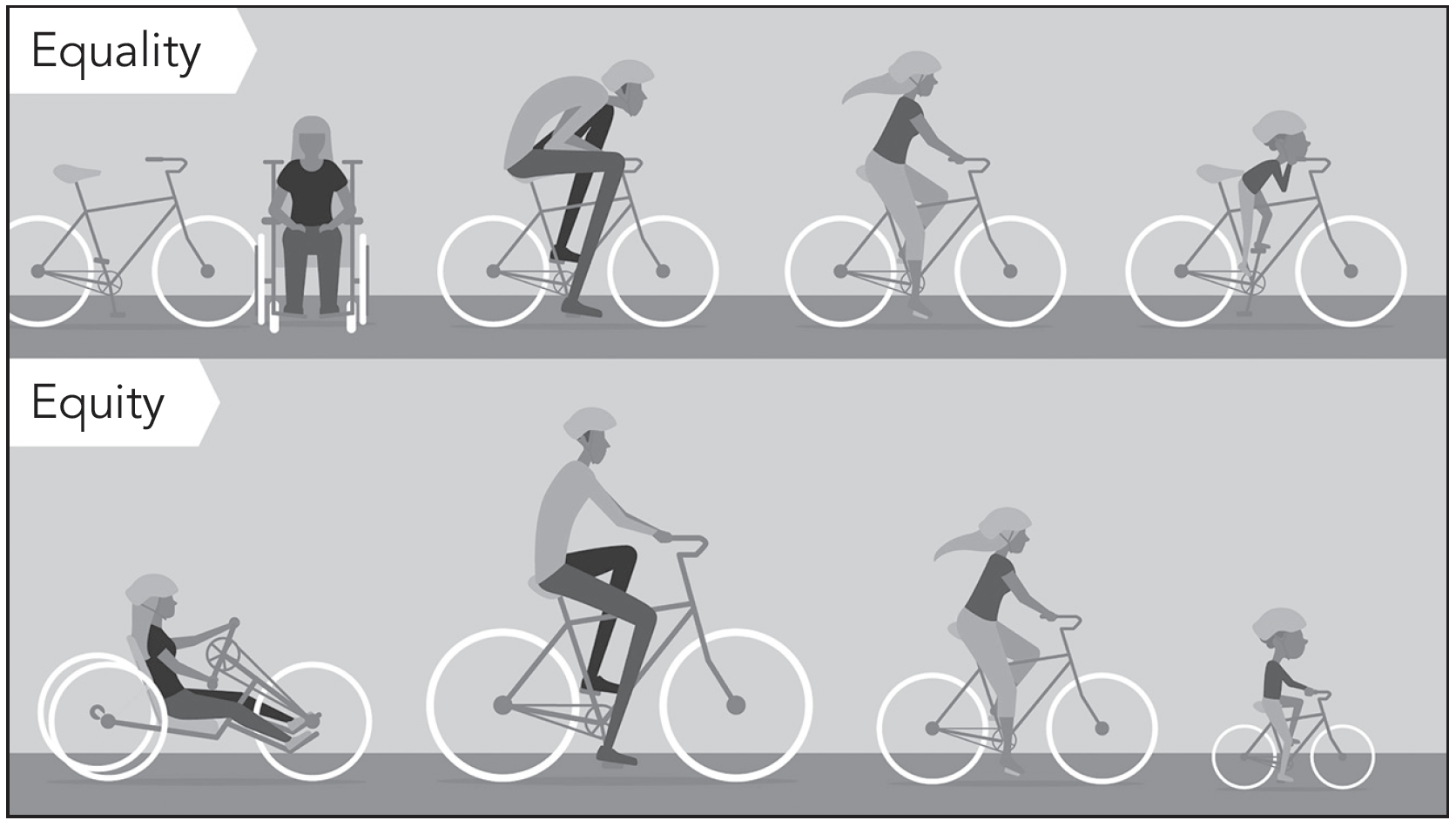
Figure 1. Equality versus equity. Courtesy of the Robert Wood Johnson Foundation.[7]
Equity does not fault people for being different; it makes room for difference and then leverages it. In other words, equitable cultures, systems, and organizations are designed so everyone in the system has an equal chance to thrive. By thrive, I mean they have an equal chance to do work that fulfills them, live life authentically, and contribute their strengths to the community, organization, or culture of which they are a part.
This does not mean equality is bad. Sometimes equality is the appropriate response; in the movement for marriage equality, for example, “separate but equal” solutions like civil unions tip the scales in favor of injustice and second-class status for LGBTQ+ Americans. Only marriage equality could bring LGBTQ+ Americans the rights they deserve. But in other instances, equitable solutions, which allow for different approaches based on different needs, are sometimes ideal.
Equity has always been the middle child in the diversity, equity, and inclusion (DEI) space, the concept we all acknowledge is important but often hop over to address feelings of inclusion. And I get why: focusing on feelings is an easier and better way to promote DEI. Equity is more about strategy and systems, concepts that can make people’s heads hurt. Personally, however, I care much more about equity than inclusion. Both are important, but the former drives the latter. Inclusion without equity is toothless; organizations end up talking about how to make people “feel more included” without doing the hard systems redesign that actually yields equal pay, more diverse leadership teams, and other signs of equal access to opportunity.
Originally from English law, the concept of equity was developed to “supplement, aid, or override common and statute law in order to protect rights and enforce duties fixed by substantive law.”[8] In other words, it allowed societies to live the spirit of the law rather than the letter of the law. The legal concept of equity recognizes that people with power must use discretion when meting out legal decisions to ensure fairness.
Equity in the workplace is about designing a system, a culture, or an organization so that everyone has an equal shot, however they may define what they are shooting for (success, happiness, work-life balance, etc.). It’s not about socialism versus capitalism or communalism versus independence. Rather, equity recognizes our interdependence and uses our collective power to create an environment where we all thrive and contribute our strengths. Moreover, equity gets us out of the hard work of constantly going against the system by creating a system that makes it easy to opt in to inclusive and equitable behaviors. Instead of looking for women to promote, for example, equity builds a system where women’s needs are centered; thereby, having women in positions of leadership becomes logical and natural.
To be clear, I am not calling for the design of an idealistic utopia. To paraphrase a Buddhist expression, the world is strewn with glass and thorns; trying to carpet it all is a fool’s errand. I am intimately aware that life is inherently unfair; even if we were to solve all human-made injustices in the world, people would still die tragically and develop incurable diseases. By the end, life breaks everyone’s heart.
However, amid such unfairness and heartbreak, I believe that the greatest expression of our humanity is the creation of fairness. In my mind, it rivals the creation of beauty and the expression of truth, which have been human pursuits since we were drawing on the inside of caves. Equity is how our human soul resists the temptation of revenge born of grief and sorrow. It is a virtue that leads us to a higher expression of our true nature. It’s how we embrace interdependence so that we can design systems that work as well for others as they do for ourselves.
Adapted from Equity: How to Design Organizations Where Everyone Thrives.
Published by Berrett-Koehler Publishers.
Copyright ©2021 by Minal Bopaiah.
ABOUT THE AUTHOR
Minal Bopaiah is the founder of Brevity & Wit, a strategy and design firm that helps organizations achieve the change they wish to see in the world through a unique approach that combines human-centered design, behavior change science, and the principles of inclusion, diversity, equity, and accessibility. Bopaiah has written for the Stanford Social Innovation Review and TheHill.com and has been a featured guest on numerous podcasts and shows, including the Kojo Nnamdi Show on WAMU. She has also been a keynote speaker for many conferences, inspiring thousands with her credible, authentic, and engaging talks.

